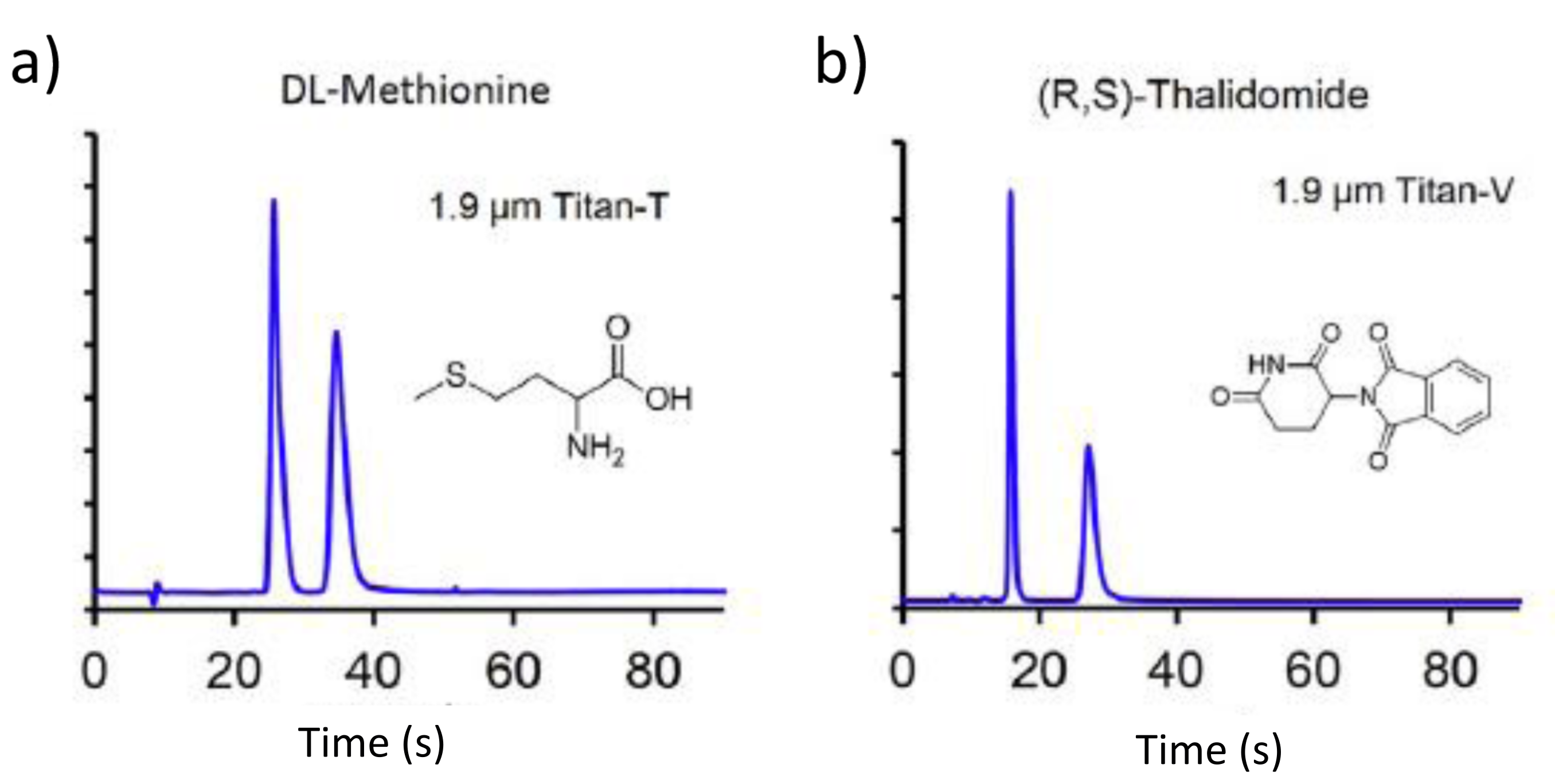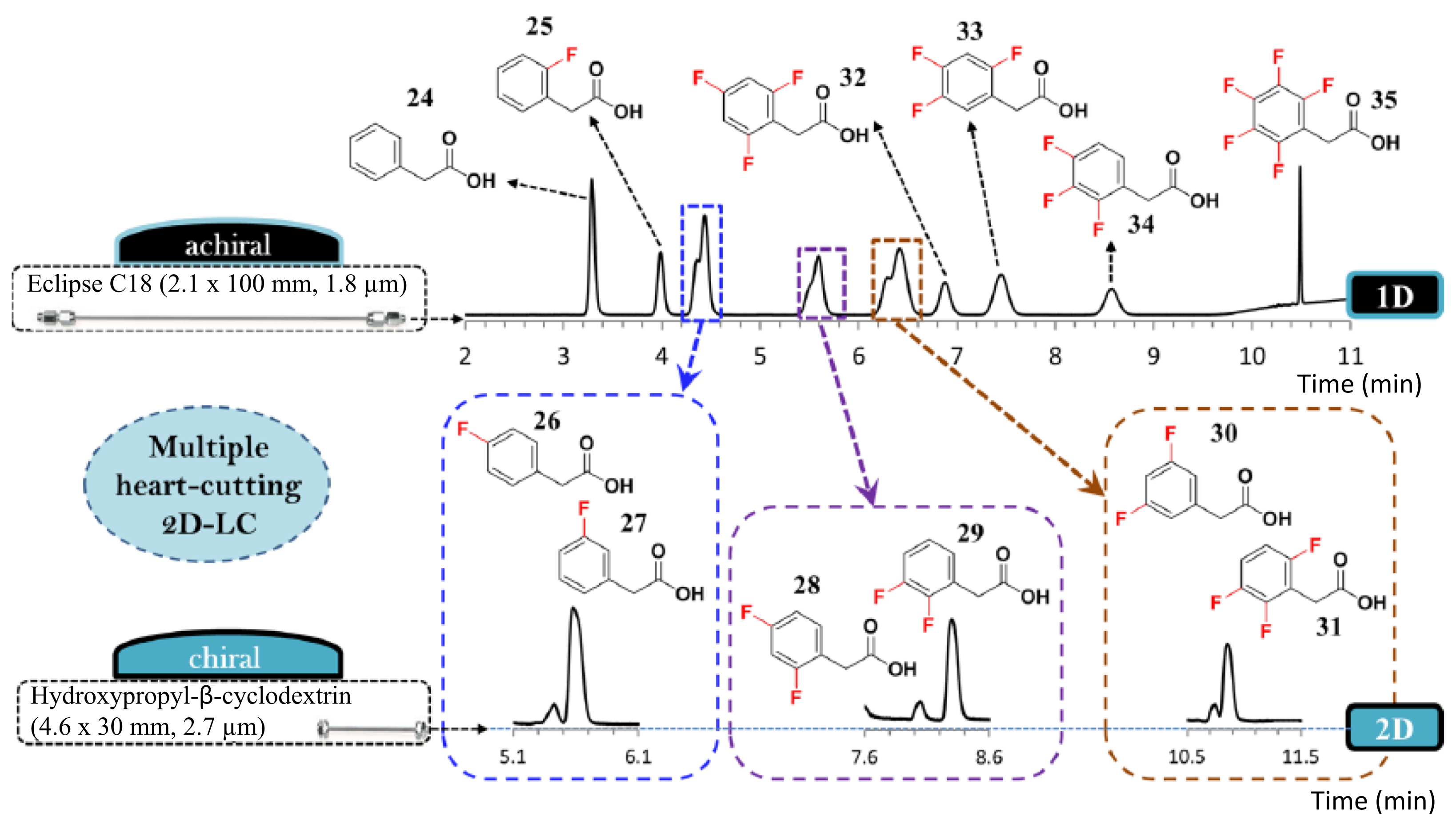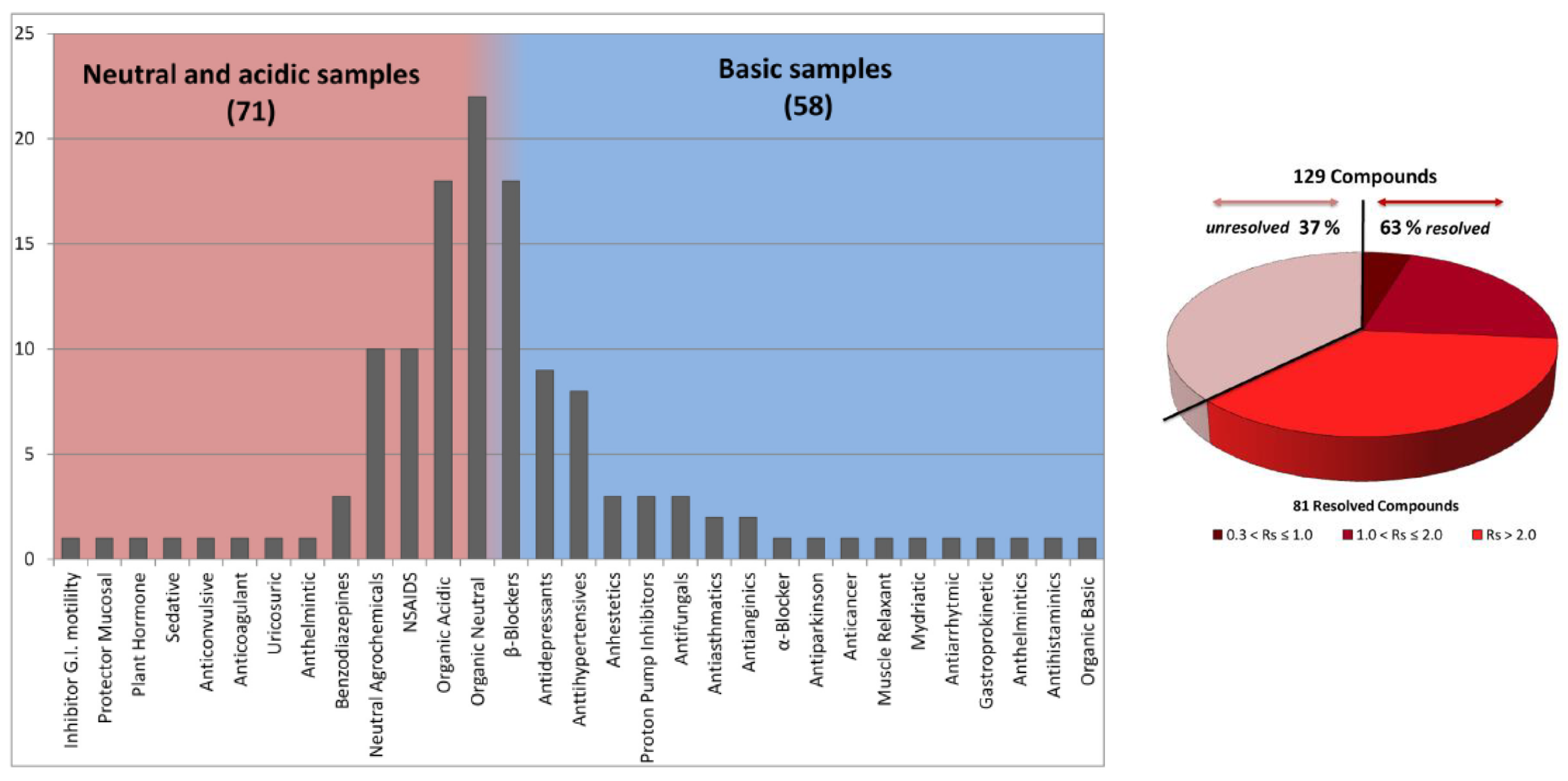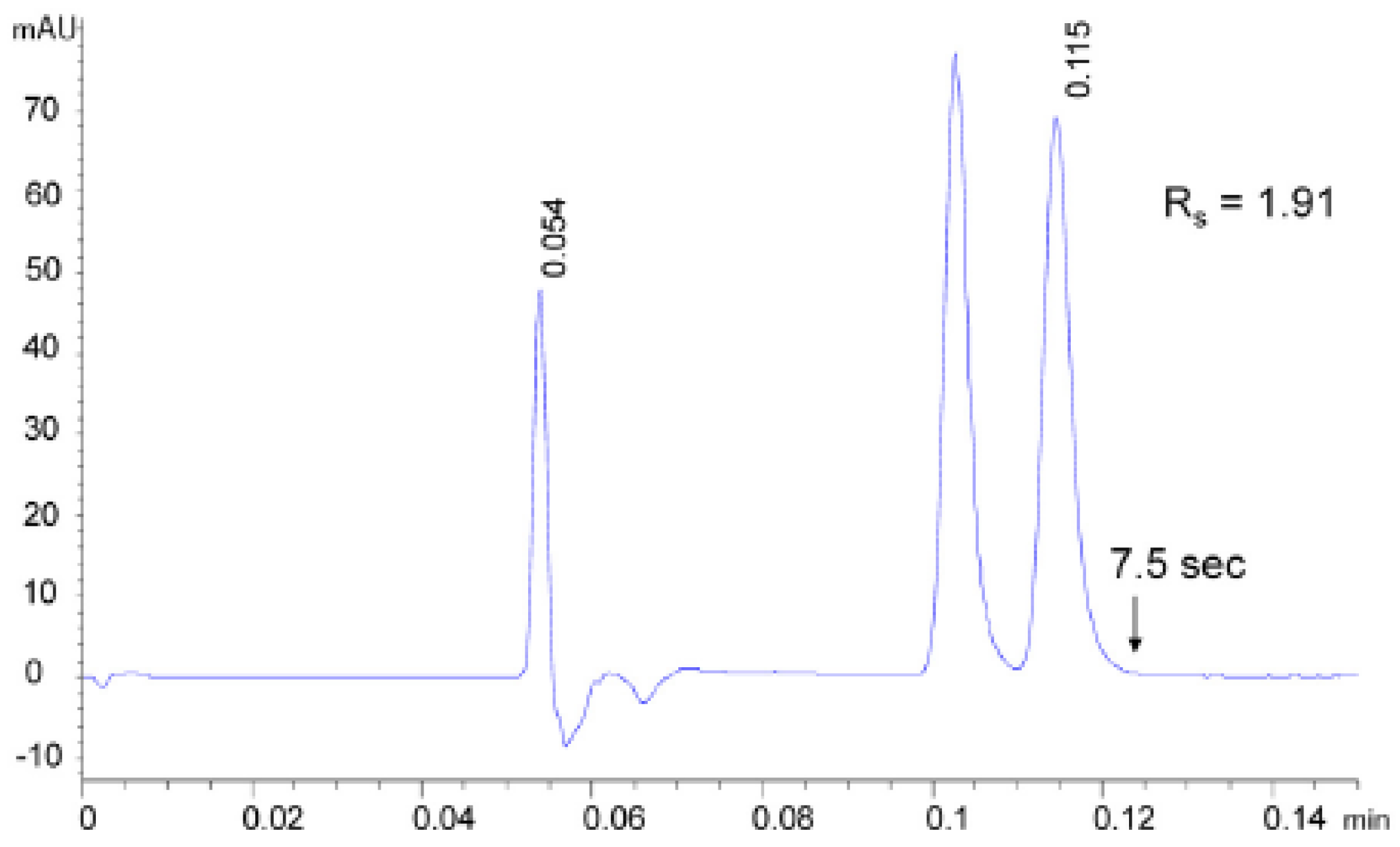The Way to Ultrafast, High-Throughput Enantioseparations of Bioactive Compounds in Liquid and Supercritical Fluid Chromatography
Abstract
:1. Introduction
2. Theory Background
3. Recent Achievements in Ultrafast, High-Throughput UHPLC Enantioseparations
3.1. CSPs Based on FPPs
3.2. CSPs Based on SPPs
3.3. Instrumental Limitations
4. Advances in Ultrafast, High-Throughput SFC Enantioseparations
Instrumental Limitations
5. Final Remarks
Author Contributions
Funding
Conflicts of Interest
References
- Cavazzini, A.; Pasti, L.; Massi, A.; Marchetti, N.; Dondi, F. Recent applications in chiral high performance liquid chromatography: A review. Anal. Chim. Acta 2011, 706, 205–222. [Google Scholar] [CrossRef] [PubMed]
- Patel, D.C.; Breitbach, Z.S.; Wahab, M.F.; Barhate, C.L.; Armstrong, D.W. Gone in seconds: Praxis, performance and peculiarities of ultrafast chiral liquid chromatography with superficially porous particles. Anal. Chem. 2015, 87, 9137–9148. [Google Scholar] [CrossRef] [PubMed]
- Ciogli, A.; Ismail, O.H.; Mazzoccanti, G.; Villani, C.; Gasparrini, F. Enantioselective ultra high performance liquid and supercritical fluid chromatography: The race to the shortest chromatogram. J. Sep. Sci. 2018, 41, 1307–1318. [Google Scholar] [CrossRef] [PubMed]
- Catani, M.; Ismail, O.H.; Gasparrini, F.; Antonelli, M.; Pasti, L.; Marchetti, N.; Felletti, S.; Cavazzini, A. Recent advancements and future directions of superficially porous chiral stationary phases for ultrafast high-performance enantioseparations. Analyst 2017, 142, 555–566. [Google Scholar] [CrossRef] [PubMed]
- Ismail, O.H.; Antonelli, M.; Ciogli, A.; Villani, C.; Cavazzini, A.; Catani, M.; Felletti, S.; Bell, D.S.; Gasparrini, F. Future perspectives in high efficient and ultrafast chiral liquid chromatography through zwitterionic teicoplanin-based 2 μm superficially porous particles. J. Chromatogr. A 2017, 1520, 91–102. [Google Scholar] [CrossRef] [PubMed]
- Ismail, O.H.; Catani, M.; Pasti, L.; Cavazzini, A.; Ciogli, A.; Villani, C.; Kotoni, D.; Gasparrini, F.; Bell, D.S. Experimental evidence of the kinetic performance achievable with columns packed with the new 1.9 μm fully porous particles Titan C18. J. Chromatogr. A 2016, 1454, 86–92. [Google Scholar] [CrossRef] [PubMed]
- Catani, M.; Ismail, O.H.; Cavazzini, A.; Ciogli, A.; Villani, C.; Pasti, L.; Cabooter, D.; Desmet, G.; Gasparrini, F.; Bell, D.S. Rationale behind the optimum efficiency of columns packed with the new 1.9 μm fully porous particles Titan C18. J. Chromatogr. A 2016, 1454, 78–85. [Google Scholar] [CrossRef] [PubMed]
- Cancelliere, G.; Ciogli, A.; D’Acquarica, I.; Gasparrini, F.; Kocergin, J.; Misiti, D.; Pierini, M.; Ritchie, H.; Simone, P.; Villani, C. Transition from enantioselective high performance to ultra-high performance liquid chromatography: A case study of a brush-type chiral stationary phase based on sub-5-micron to sub-2-micron silica particles. J. Chromatogr. A 2010, 1217, 990–999. [Google Scholar] [CrossRef] [PubMed]
- Kotoni, D.; Ciogli, A.; Molinaro, C.; D’Acquarica, I.; Kocergin, J.; Szczerba, T.; Ritchie, H.; Villani, C.; Gasparrini, F. Introducing enantioselective Ultrahigh-Pressure Liquid Chromatography (eUHPLC): Theoretical inspections and ultrafast separations on a new sub-2-μm Whelk-O1 stationary phase. Anal. Chem. 2012, 84, 6805–6813. [Google Scholar] [CrossRef] [PubMed]
- Kotoni, D.; Ciogli, A.; D’Acquarica, I.; Kocergin, J.; Szczerba, T.; Ritchie, H.; Villani, C.; Gasparrini, F. Enantioselective ultra-high and high performance liquid chromatography: A comparative study of columns based on the Whelk-O1 selector. J. Chromatogr. A 2012, 1269, 226–241. [Google Scholar] [CrossRef] [PubMed]
- Cavazzini, A.; Marchetti, N.; Guzzinati, R.; Pierini, M.; Ciogli, A.; Kotoni, D.; D’Acquarica, I.; Villani, C.; Gasparrini, F. Enantioseparation by ultra-high-performance liquid chromatography. Trends Anal. Chem. 2014, 63, 95–103. [Google Scholar] [CrossRef]
- Reischl, R.J.; Hartmanova, L.; Carrozzo, M.; Huszar, M.; Frühauf, P.; Lindner, W. Chemoselective and enantioselective analysis of proteinogenic amino acids utilizing N-derivatization and 1-D enantioselective anion-exchange chromatography in combination with tandem mass spectrometric detection. J. Chromatogr. A 2011, 1218, 8379–8387. [Google Scholar] [CrossRef] [PubMed]
- Lomsadze, K.; Jibuti, G.; Farkas, T.; Chankvetadze, B. Comparative high-performance liquid chromatography enantioseparations on polysaccharide based stationary phases prepared by coating totally porous and core-shell silica particles. J. Chromatogr. A 2012, 1234, 50–55. [Google Scholar] [CrossRef] [PubMed]
- Spudeit, D.A.; Dolzan, M.D.; Breitbach, Z.S.; Barber, W.E.; Micke, G.A.; Armstrong, D.W. Superficially porous particles vs. fully porous particles for bonded high performance liquid chromatographic chiral stationary phases: Isopropyl cyclofructan 6. J. Chromatogr. A 2014, 1363, 89–95. [Google Scholar] [CrossRef] [PubMed]
- Barhate, C.L.; Breitbach, Z.S.; Pinto, E.C.; Regalado, E.L.; Welch, C.J.; Armstrong, D.W. Ultrafast separation of fluorinated and desfluorinated pharmaceuticals using highly efficient and selective chiral selectors bonded to superficially porous particles. J. Chromatogr. A 2015, 1426, 241–247. [Google Scholar] [CrossRef] [PubMed]
- Patel, D.C.; Wahab, M.F.; Armstrong, D.W.; Breitbach, Z.S. Advances in high-throughput and high-efficiency chiral liquid chromatographic separations. J. Chromatogr. A 2016, 1467, 2–18. [Google Scholar] [CrossRef] [PubMed]
- Patel, D.C.; Wahab, M.F.; Armstrong, D.W.; Breitbach, Z.S. Salient sub-second separations. Anal. Chem. 2016, 88, 8821–8826. [Google Scholar]
- Barhate, C.L.; Lopez, D.A.; Makarov, A.A.; Bu, X.; Morris, W.J.; Lekhal, A.; Hartman, R.; Armstrong, D.W.; Regalado, E.L. Macrocyclic glycopeptide chiral selectors bonded to core-shell particles enables enantiopurity analysis of the entire verubecestat synthetic route. J. Chromatogr. A 2018, 1539, 87–92. [Google Scholar] [CrossRef] [PubMed]
- Guiochon, G.; Gritti, F. Shell particles, trials, tribulations and triumphs. J. Chromatogr. A 2011, 1218, 1915–1938. [Google Scholar] [CrossRef] [PubMed]
- Gritti, F.; Guiochon, G. Mass transfer mechanism in chiral reversed phase liquid chromatography. J. Chromatogr. A 2014, 1332, 35–45. [Google Scholar] [CrossRef] [PubMed]
- Gritti, F.; Guiochon, G. Possible resolution gain in enantioseparations afforded by core-shell particle technology. J. Chromatogr. A 2014, 1348, 87–96. [Google Scholar] [CrossRef] [PubMed]
- Catani, M.; Felletti, S.; Ismail, O.H.; Gasparrini, F.; Pasti, L.; Marchetti, N.; Luca, C.D.; Costa, V.; Cavazzini, A. New frontiers and cutting edge applications in ultra high performance liquid chromatography through latest generation superficially porous particles with particular emphasis to the field of chiral separations. Anal. Bioanal. Chem. 2018, 410, 2457–2465. [Google Scholar] [CrossRef] [PubMed]
- Felletti, S.; De Luca, C.; Ismail, O.H.; Pasti, L.; Costa, V.; Gasparrini, F.; Cavazzini, A.; Catani, M. On the effect of chiral selector loading and mobile phase composition on adsorption properties of latest generation fully- and superficially-porous Whelk-O1 particles for high-efficient ultrafast enantioseparations. J. Chromatogr. A 2018. [Google Scholar] [CrossRef]
- Gritti, F.; Farkas, T.; Heng, J.; Guiochon, G. On the relationship between band broadening and the particle-size distribution of the packing material in liquid chromatography: Theory and practice. J. Chromatogr. A 2011, 1218, 8209–8221. [Google Scholar] [CrossRef] [PubMed]
- Cavazzini, A.; Gritti, F.; Kaczmarski, K.; Marchetti, N.; Guiochon, G. Mass-Transfer Kinetics in a Shell Packing Material for Chromatography. Anal. Chem. 2007, 79, 5972–5979. [Google Scholar] [CrossRef] [PubMed]
- Marchetti, N.; Cavazzini, A.; Gritti, F.; Guiochon, G. Gradient elution separation and peak capacity of columns packed with porous shell particles. J. Chromatogr. A 2007, 1163, 203–211. [Google Scholar] [CrossRef] [PubMed]
- Gritti, F.; Cavazzini, A.; Marchetti, N.; Guiochon, G. Comparison between the efficiencies of columns packed with fully and partially porous C18-bonded silica materials. J. Chromatogr. A 2007, 1157, 289–303. [Google Scholar] [CrossRef] [PubMed]
- Catani, M.; Ismail, O.H.; Felletti, S.; Gasparrini, F.; Pasti, L.; Costa, V.; Cavazzini, A. Pirkle-type chiral stationary phases for ultra-high performance ultra-fast enantioseparations. Am. Pharm. Rev. 2017, 20, 44–48. [Google Scholar]
- Barhate, C.L.; Wahab, M.F.; Breitbach, Z.S.; Bell, D.S.; Armstrong, D.W. High efficiency, narrow particle size distribution, sub-2 μm based macrocyclic glycopeptide chiral stationary phases in HPLC and SFC. Anal. Chim. Acta 2015, 898, 128–137. [Google Scholar] [CrossRef] [PubMed]
- Ismail, O.H.; Antonelli, M.; Ciogli, A.; De Martino, M.; Catani, M.; Villani, C.; Cavazzini, A.; Ye, M.; Bell, D.S.; Gasparrini, F. Direct analysis of chiral active pharmaceutical ingredients and their counterions by ultra high performance liquid chromatography with macrocyclic glycopeptide-based chiral stationary phases. J. Chromatogr. A 2018. [Google Scholar] [CrossRef] [PubMed]
- Snyder, L.R. Column efficiency in liquid-solid adsorption chromatography. H.E.T.P. (height equivalent to a theoretical plate) values as a function of separation conditions. Anal. Chem. 1967, 39, 698–704. [Google Scholar] [CrossRef]
- Done, J.N.; Knox, J.H. The Performance of Packings in High Speed Liquid Chromatography II. ZIPAX®. The Effect of Particle Size. J. Chromatogr. Sci. 1972, 10, 606–612. [Google Scholar] [CrossRef]
- Halász, I.; Naefe, M. Influence of column parameters on peak broadening in high-pressure liquid chromatography. Anal. Chem. 1972, 44, 76–84. [Google Scholar] [CrossRef]
- Endele, R.; Halász, I.; Unger, K. Influence of the particle size (5–35 μm) of spherical silica on column efficiency in HPLC. J. Chromatogr. A 1974, 99, 377–393. [Google Scholar] [CrossRef]
- Cabooter, D.; Fanigliulo, A.; Bellazzi, G.; Allieri, B.; Rottigni, A.; Desmet, G. Relationship between the particle size distribution of commercial fully porous and superficially porous high-performance liquid chromatography column packings and their chromatographic performance. J. Chromatogr. A 2010, 1217, 7074–7081. [Google Scholar] [CrossRef] [PubMed]
- Reising, A.E.; Godinho, J.M.; Hormann, K.; Jorgenson, J.W.; Tallarek, U. Larger voids in mechanically stable, loose packings of 1.3 μm frictional, cohesive particles: Their reconstruction, statistical analysis, and impact on separation efficiency. J. Chromatogr. A 2016, 1436, 118–132. [Google Scholar] [CrossRef] [PubMed]
- Gritti, F.; Bell, D.S.; Guiochon, G. Particle size distribution and column efficiency. An ongoing debate revived with 1.9 μm Titan-C18 particles. J. Chromatogr. A 2014, 1355, 179–192. [Google Scholar] [CrossRef] [PubMed]
- Gritti, F.; Guiochon, G. The rationale for the optimum efficiency of columns packed with new 1.9 μm fully porous Titan-C18 particles. A detailed investigation of the intra-particle diffusivity. J. Chromatogr. A 2014, 1355, 164–178. [Google Scholar] [CrossRef] [PubMed]
- Kawatzki, K.; Barhate, C.L.; Regalado, E.L.; Mann, B.F.; Marshall, N.; Moore, J.C.; Welch, C.J. Overcoming “speed limits” in high throughput chromatographic analysis. J. Chromatogr. A 2017, 1499, 211–216. [Google Scholar]
- Barhate, C.L.; Regalado, E.L.; Contrella, N.D.; Lee, J.; Jo, J.; Makarov, A.A.; Armstrong, D.W.; Welch, C.J. Ultrafast Chiral Chromatography as the Second Dimension in Two-Dimensional Liquid Chromatography Experiments. Anal. Chem. 2017, 89, 3545–3553. [Google Scholar] [CrossRef] [PubMed]
- Khundadze, N.; Pantsulaia, S.; Fanali, C.; Farkas, T.; Chankvetadze, B. On our way to sub-second separations of enantiomers in high-performance liquid chromatography. J. Chromatogr. A 2018, 1572, 37–43. [Google Scholar] [CrossRef] [PubMed]
- Thrumann, S.; Lotter, C.; Heiland, J.J.; Chankvetadze, B.; Belder, D. Chip-based high-performance liquid chromatography for high-speed enantioseparations. Anal. Chem. 2015, 87, 5568–5576. [Google Scholar] [CrossRef] [PubMed]
- Patel, D.C.; Wahab, M.F.; O’Haver, T.C.; Armstrong, D.W. Separations at the speed of sensors. Anal. Chem. 2018, 90, 3349–3356. [Google Scholar] [CrossRef] [PubMed]
- Wimalasinghe, R.M.; Weatherly, C.A.; Breitbach, Z.S.; Armstrong, D.W. Hydroxypropyl beta cyclodextrin bonded superficially porous particlebased HILIC stationary phases. J. Liq. Chromatogr. Relat. Technol. 2016, 39, 459–464. [Google Scholar] [CrossRef]
- Woiwode, U.; Neubauer, S.; Lindner, W.; Buckenmaier, S.; Lämmerhofer, M. Enantioselective multiple heartcut two-dimensional ultra-high-performance liquid chromatography method with a Coreshell chiral stationary phase in the second dimension for analysis of all proteinogenic amino acids in a single run. J. Chromatogr. A 2018, 1562, 69–77. [Google Scholar] [CrossRef] [PubMed]
- Woiwode, U.; Reischl, R.J.; Buckenmaier, S.; Lindner, W.; Lämmerhofer, M. Imaging peptide and protein chirality via amino acid analysis by chiral × chiral two-dimensional correlation liquid chromatography. Anal. Chem. 2018, 90, 7963–7971. [Google Scholar] [CrossRef] [PubMed]
- Min, Y.; Sui, Z.; Liang, Z.; Zhang, L.; Zhang, Y. Teicoplanin bonded sub-2 μm superficially porous particles for enantioseparation of native amino acids. J. Pharm. Biomed. Anal. 2015, 114, 247–253. [Google Scholar] [CrossRef] [PubMed]
- Felinger, A.; Kilár, A.; Boros, B. The myth of data acquisition rate. Anal. Chim. Acta 2015, 854, 178–182. [Google Scholar] [CrossRef] [PubMed]
- Patel, D.C.; Wahab, M.F.; O’Haver, T.C.; Armstrong, D.W. Recent achievements and future challenges in supercritical fluid chromatography for the enantioselective separation of chiral pharmaceuticals. Chromatographia 2018, 1–11. [Google Scholar] [CrossRef]
- Ismail, O.H.; Ciogli, A.; Villani, C.; Martino, M.D.; Pierini, M.; Cavazzini, A.; Bell, D.S.; Gasparrini, F. Ultra-fast high-efficiency enantioseparations by means of a teicoplanin-based chiral stationary phase made on sub-2 μm totally porous silica particles of narrow size distribution. J. Chromatogr. A 2016, 1427, 55–68. [Google Scholar] [CrossRef] [PubMed]
- Sciascera, L.; Ismail, O.; Ciogli, A.; Kotoni, D.; Cavazzini, A.; Botta, L.; Szczerba, T.; Kocergin, J.; Villani, C.; Gasparrini, F. Expanding the potential of chiral chromatography for high-throughput screening of large compound libraries by means of sub-2 μm Whelk-O1 stationary phase in supercritical fluid conditions. J. Chromatogr. A 2015, 1383, 160–168. [Google Scholar] [CrossRef] [PubMed]
- Patel, D.C.; Breitbach, Z.S.; Yu, J.; Nguyen, K.A.; Armstrong, D.W. Quinine bonded to superficially porous particles for high-efficiency and ultrafast liquid and supercritical fluid chromatography. Anal. Chim. Acta 2017, 963, 164–174. [Google Scholar] [CrossRef] [PubMed]
- Berger, T.A. Kinetic performance of a 50 mm long 1.8 μm chiral column in supercritical fluid chromatography. J. Chromatogr. A 2016, 1459, 136–144. [Google Scholar] [CrossRef] [PubMed]
- Berger, T.A. Preliminary kinetic evaluation of an immobilized polysaccharide sub-2 μm column using a low dispersion supercritical fluid chromatograph. J. Chromatogr. A 2017, 1510, 82–88. [Google Scholar] [CrossRef] [PubMed]
- Ismail, O.H.; Losacco, G.L.; Mazzoccanrti, G.; Ciogli, A.; Villani, C.; Catani, M.; Pasti, L.; Anderson, S.; Cavazzini, A.; Gasparrini, F. Unmatched kinetic performance in enantioselective supercritical fluid chromatography by combining latest generation Whelk-O1 chiral stationary phases with a low-dispersion in-house modified equipment. Anal. Chem. 2018, 90, 10828–10836. [Google Scholar] [CrossRef] [PubMed]




© 2018 by the authors. Licensee MDPI, Basel, Switzerland. This article is an open access article distributed under the terms and conditions of the Creative Commons Attribution (CC BY) license (http://creativecommons.org/licenses/by/4.0/).
Share and Cite
Ismail, O.H.; Felletti, S.; Luca, C.D.; Pasti, L.; Marchetti, N.; Costa, V.; Gasparrini, F.; Cavazzini, A.; Catani, M. The Way to Ultrafast, High-Throughput Enantioseparations of Bioactive Compounds in Liquid and Supercritical Fluid Chromatography. Molecules 2018, 23, 2709. https://doi.org/10.3390/molecules23102709
Ismail OH, Felletti S, Luca CD, Pasti L, Marchetti N, Costa V, Gasparrini F, Cavazzini A, Catani M. The Way to Ultrafast, High-Throughput Enantioseparations of Bioactive Compounds in Liquid and Supercritical Fluid Chromatography. Molecules. 2018; 23(10):2709. https://doi.org/10.3390/molecules23102709
Chicago/Turabian StyleIsmail, Omar H., Simona Felletti, Chiara De Luca, Luisa Pasti, Nicola Marchetti, Valentina Costa, Francesco Gasparrini, Alberto Cavazzini, and Martina Catani. 2018. "The Way to Ultrafast, High-Throughput Enantioseparations of Bioactive Compounds in Liquid and Supercritical Fluid Chromatography" Molecules 23, no. 10: 2709. https://doi.org/10.3390/molecules23102709
APA StyleIsmail, O. H., Felletti, S., Luca, C. D., Pasti, L., Marchetti, N., Costa, V., Gasparrini, F., Cavazzini, A., & Catani, M. (2018). The Way to Ultrafast, High-Throughput Enantioseparations of Bioactive Compounds in Liquid and Supercritical Fluid Chromatography. Molecules, 23(10), 2709. https://doi.org/10.3390/molecules23102709






